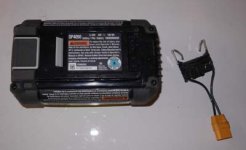Alan B
100 GW
Even at 6% the conductivity of copper, the resistance is still quite low. But it might get warm at high current. The amount of material in the blade is significant, so essentially there are a bunch of parallel paths through the blade to the wire. I just haven't found anything better other than pure copper which tarnishes badly in a hurry.
I could go a different direction, and use silver plated copper. I have the silver plating powder that works on copper switch and relay contacts as well as printed circuit boards (best used before the holes are drilled), it would work fine on some copper sheet. Let's see how bad this alloy is first.
It partly depends on whether one is going to parallel two packs, then the current through each contact drops in half. But let's see how much resistance is in one of these contact blades:
The cross sectional area of the contact is 0.8 x 20mm = 16 square mm which is equivalent to a wire of 4.5 mm circular diameter. which is about 5 gauge and has a resistance of about 0.31 Milliohms per foot in copper. We're going about 0.7 inches here, so 0.018 milliohms across one contact if it were copper, for this nickel-silver alloy (which contains no silver, it's just a name), is 17 times higher so the resulting resistance is 0.31 milliohms per contact. At say 20 amps this will dissipate 0.124 watts. At 30 amps it would be just over twice that value. It might warm up a little, but probably not much. Paralleling two packs would reduce the heating quite a bit, 1/4 in each contact, 1/2 total due to I squared R.
I don't think I'll order any copper just yet. Let's test it and see if we have any problems with the nickel silver first.
I could go a different direction, and use silver plated copper. I have the silver plating powder that works on copper switch and relay contacts as well as printed circuit boards (best used before the holes are drilled), it would work fine on some copper sheet. Let's see how bad this alloy is first.
It partly depends on whether one is going to parallel two packs, then the current through each contact drops in half. But let's see how much resistance is in one of these contact blades:
The cross sectional area of the contact is 0.8 x 20mm = 16 square mm which is equivalent to a wire of 4.5 mm circular diameter. which is about 5 gauge and has a resistance of about 0.31 Milliohms per foot in copper. We're going about 0.7 inches here, so 0.018 milliohms across one contact if it were copper, for this nickel-silver alloy (which contains no silver, it's just a name), is 17 times higher so the resulting resistance is 0.31 milliohms per contact. At say 20 amps this will dissipate 0.124 watts. At 30 amps it would be just over twice that value. It might warm up a little, but probably not much. Paralleling two packs would reduce the heating quite a bit, 1/4 in each contact, 1/2 total due to I squared R.
I don't think I'll order any copper just yet. Let's test it and see if we have any problems with the nickel silver first.



